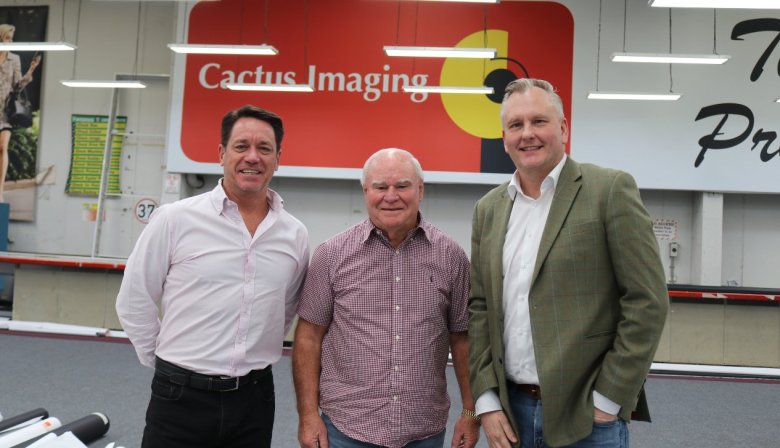
When asked why invest in the Southern Hemisphere’s first high-speed Durst P5 350 HS D4 hybrid press, Cactus Imaging’s Nigel Spicer and Keith Ferrel responded with the same reason: versatility.
Speed (708 square metres per hour in two-pass mode) was the next reason, quickly followed by the super easy way the machine can be switched between a roll-to-roll and flatbed application (10 seconds according to Ferrel).
“We’ve been looking at flatbeds for years and years but they were printing at 20 square metres an hour and that was just a waste of time for us,” Ferrel, the general manager – operations and co-founder of Cactus Imaging, told Sprinter.
“This one will do up to 700 square metres an hour but the beauty of it being a hybrid means we can print billboards, street furniture, vinyl, and a multitude of things so it is versatile and diverse in what it does. It is the first one in this part of the world too – in fact I think it is only the second one in the world.”
Prior to the arrival of this new machine – expected in January/February 2023 – the team at Cactus have been printing and mounting onto board but as customer demand grew, it became clear that opting for a faster flatbed print solution was required.
Spicer, the general manager of Cactus Imaging, said the latest Durst addition will open up new opportunities due to the flatbed capabilities.
“The key things for us are the versatility of it to get across to different markets and the speed and the quality,” Spicer said.
“We are excited about the opportunities it will bring for us. We have listened to a lot of our clients and they have encouraged us to go down the path of having flatbed and roll-to-roll as the market diversifies.
“We are now committed to it and we are very excited about it. The business is going well and we are getting a lot of support from the market so it is a good time to move.”
The other big attraction was the incredibly simple changeover method for adding the flatbed feature. It does not require the removal of the rolls, with the flatbed table simply wheeled up to the machine and attached in a simple process. When flatbed printing is not necessary, the table can be wheeled away, folded up and stored.
“That takes about 10 seconds. It is more wheeling the table up to it and going from there. In the early days the hybrids would take you 25 to 30 minutes to bring a table up and connect it up but this takes 10 seconds and the other beauty is if you have got roll-to-roll running, you don’t have to take the rolls off it at all because the table just goes over the top,” Ferrel said.
The new Durst P5 350 HS D4 utilises a double CMYK colour configuration – hence the D4.
For those printers out there with a Durst P5 350 HS or the 2.1 metre wide Durst P5 210 HS, it is also possible to field upgrade with the double CMYK colour configuration to increase speed.
Durst Oceania managing director Matt Ashman said, “Cactus Imaging is a true leader and pioneer in the digital wide format space and it thrills me to see Keith Ferrel and Nigel Spicer have again put themselves at the forefront with this investment.
“At Durst we are confident the speed, quality and versatility of this hybrid press will aid Cactus Imaging in its future growth plans.
“I thank Keith and Nigel for having faith in Durst’s quality and ability to greatly assist in the ongoing success of Cactus Imaging.”
Comment below to have your say on this story.
If you have a news story or tip-off, get in touch at editorial@sprinter.com.au.
Sign up to the Sprinter newsletter
